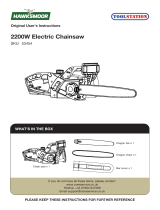
7
Causes and operator prevention of kickback
Kickback may occur when the nose or tip of the guide bar
touches an object, or when the wood closes in and pinches
the saw chain in the cut.
Tip contact in some cases may cause a sudden reverse
reaction, kicking the guide bar up and back towards the
operator.
Pinching the saw chain along the top of the guide bar may
push the guide bar rapidly back towards the operator.
Either of these reactions may cause you to lose control of the
chainsaw which could result in serious personal injury. Do
not rely exclusively upon the safety devices built into your
chainsaw. As a chainsaw user, you should take several
steps to keep your cutting jobs free from accident or injury.
Kickback is the result of tool misuse and / or incorrect
operating procedures or conditions and can be avoided by
taking proper precautions as given below:
Maintain a firm grip, with thumbs and fingers encircling
the chainsaw handles. With both hands on the
chainsaw, position your body and arm to allow you to
resist kickback forces. Kickback forces can be
controlled by the operator, if proper precautions are
taken. Do not let go of the chainsaw.
Do not overreach and do not cut above shoulder height.
This helps prevent unintended tip contact and enables
better control of the chainsaw in unexpected situations.
Only use replacement guide bars and chains specified
by the manufacturer. Incorrect replacement guide bars
and chains may cause chain breakage and/or kickback.
Follow the manufacturer's sharpening and maintenance
instructions for the saw chain. Decreasing the depth
gauge height can lead to increased kickback.
Safety recommendations for the chainsaw
We strongly recommend that first time users obtain
practical instruction in the use of the chainsaw and
protective equipment from an experienced user. Initial
practice should be completed sawing logs on a saw
horse or cradle.
We recommend that when carrying the chainsaw that
you make sure that the brake is engaged
Maintain your chainsaw when not in use. Do not store
your chainsaw for any length of time without first
removing the saw chain and guide bar which should be
kept immersed in oil. Store all parts of your chainsaw in
a dry, secure place out of reach of children.
We recommend you drain the oil reservoir prior to
storage.
Be sure of your footing and pre-plan a safe exit from a
falling tree or branches.
Use wedges to help control felling and prevent binding
the guide bar and saw chain in the cut.
Saw chain care. Keep the saw chain sharp and snug on
the guide bar. Ensure the saw chain and guide bar are
clean and well oiled. Keep handles dry, clean and free
from oil and grease.
Kickback can be caused by:
Striking branches or other objects accidentally with a tip
of the saw while the saw chain is moving.
Striking metal, cement or any other hard material near
the wood, or buried in the wood.
A dull or loose chain.
Cutting above shoulder height.
Lack of attention when holding or guiding the chainsaw
while cutting.
Over-reaching. Keep proper footing and balance at all
times and do not overreach.
Do not try to insert into a previous cut. As this could
cause kickback. Make a fresh cut every time.
We strongly recommend you do not attempt to operate
your chainsaw while in a tree, on a ladder or on any
other unstable surface. If you decide to do so, be
advised that these positions are extremely dangerous.
When cutting a branch that is under tension, be alert for
spring back so that you will not be struck when the
tension is released.
Avoid cutting:
Prepared timber.
Into the ground.
Into wire fences, nails. etc.
Into small sized brush and saplings because slender
material may catch the saw chain and be whipped
towards you, or pull you off balance.
Do not use your chainsaw above shoulder height.
Ensure someone is nearby (but at a safe distance) in
case of an accident.
If for any reason you have to touch the saw chain, make
sure your chainsaw is disconnected from the mains.
The noise from this product can exceed 80 dB(A). We
therefore recommend you take appropriate measures
for the protection of hearing.
Safety of others
This appliance is not intended for use by persons
(including children) with reduced physical, sensory or
mental capabilities, or lack of experience and
knowledge, unless they have been given supervision or
instruction concerning the use of the appliance by a
person responsible for the their safety.
Children should be supervised to ensure that they do
not play with the appliance.


















